3 essential types of shelter every block needs to keep animals comfortable
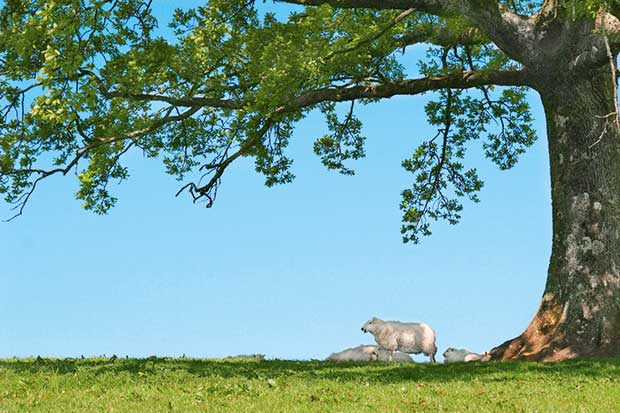
We can put on a jacket or a sunhat, turn on the air-con or add another log on the fire. But all your stock can do is move in or out of shelter. That’s why it’s important to make sure each paddock has some.
Words: Sheryn Dean
Try sitting in your paddock on a cold and wet night without putting on a coat. Not pleasant. Remember those blistering, humid 30°C+ days last summer? It’s not fun out in that sun for long either.
But these are the extremes your stock are forced to endure. Animals can’t dress according to the weather. They just have to withstand the heat, rain and wind as best they can.
Before man confined them to small squares with fences, livestock would seek the shelter of forests when conditions were adverse, stand on hill tops to catch the breeze in the heat, and huddle together in herds for extra warmth.
Confining animals to exposed paddocks is forcing them to endure all the extremes of weather and it’s not just unpleasant. It affects their health and productivity. As we start to feel the effects of climate change and experience more extremes of weather, it is just downright cruel.
Shelter, whether grown or built, is essential. Here are several ways you can achieve it.
1. THE SPECIMEN TREE
One large tree in the middle of a paddock can provide an umbrella of shade in summer and some protection from cold in winter. Singularly it is not a particularly effective wind block but several in a paddock are. Trees also look attractive, adding a park-like ambience to your property.
If a single tree is the only shelter available, animals will frequently camp underneath it. You may eventually notice a build-up of manure and change of grasses underneath. If winter mud is an issue, choose a deciduous tree which will drop its leaves in winter.
The branches provide a canopy which filters the rain and holds the ground-warmth, and the sunlight coming through will help to keep the ground dry.
Protect a tree or trees. Use a sturdy surround that can stay in place for at least 10 years.
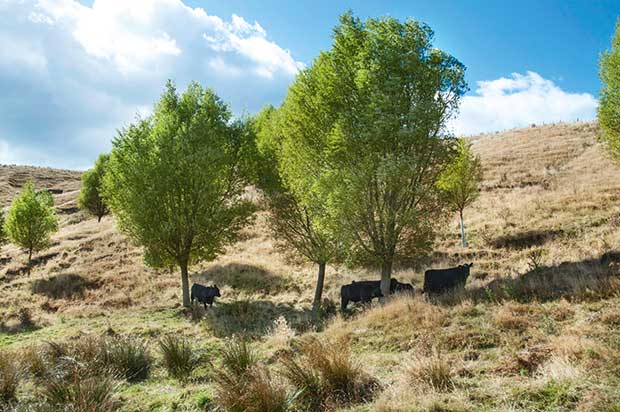
Poplar and willow provide shade and shelter, stabilise hillsides and can be cut to provide stock food when required.
If you choose a fodder tree that animals like to eat, remember it is exactly that and needs very good protection from long necks and tongues until it is large enough to withstand being nibbled. As protection is the expensive part, it is economic to plant a tree in each corner or side of a paddock to utilise existing fences and provide shelter from every direction.
When choosing a tree, always select what suits your climate and conditions. Then consider what benefits you and your stock. It is no good choosing a tree for autumn colour if you don’t get autumn chill. If you suffer from drought in summer, choose a fodder tree you can use as supplementary feed.
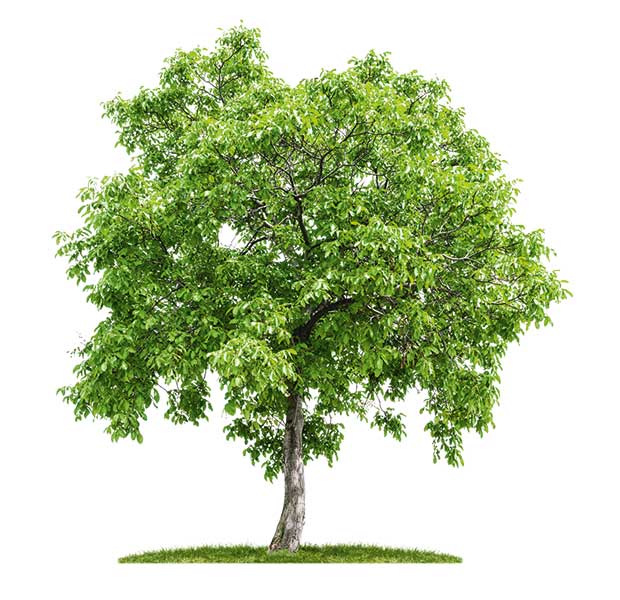
Walnut.
These trees will eventually grow large, and so will their roots. Some can reach 60m or more from the trunk. This will harvest any nutrients that leach past the grass roots, take it up into the leaves and these will then fall in autumn to feed stock or become compost for the grass.
Get robust, full-size trees on their own roots (not grafted). You don’t want the dwarf trees sold for orchards and home gardens.
They transpire a lot of moisture which helps to dry out wet, boggy ground and will grow most anywhere. Unfortunately they can be attacked by the newly-immigrated giant willow aphid. They are fantastic stock food too. In a drought when grass is short, the branches can be cut and fed out.
7 SPECIMEN TREE SUGGESTIONS
Pear
A pear tree grows large and sprawling and, best of all, produces pears. While you may not want to climb 10m to pick a pear, your grandchildren are going to build tree-huts amongst the tasty treats. The birds will love them and the stock will wait underneath for those that fall to the ground.
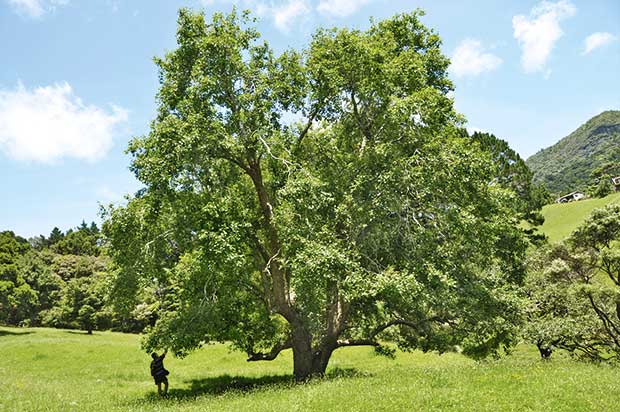
An old pear tree at Huia in the Waitakere Ranges has been producing food and shelter for as long as locals can remember.
Tip: when the tree is well-grown, plant a grapevine at the base. It will wind its way up and provide a wonderful fruit salad to those camped in the tree hut.
Walnut
One big walnut tree can provide enough to feed several families. The livestock get shelter and you get ample tasty nuts.
However, walnuts secrete a substance called juglone from their roots that can inhibit grass growing underneath them. This is not obvious in a healthy soil ecology but when combined with heavy stock camping under it, the ground underneath can turn to mud, so walnuts are not a good choice for damp areas.
Willow
A weeping willow is a graceful tree and stock will trim the drooping branches to a perfect line.

Stock nibble the weeping willow, pruning a perfect ceiling to camp under at the Guthrie Smith Arboreturm at Tutira, Hawkes Bay.
Poplar
Poplars are another good stock tree that NZ farmers have planted on their farms for food and shelter.
Poplar leaves contain zinc which stock need to combat facial eczema. They also shed their leaves in a drought, which are happily consumed by stock. Poplar trees can be relatively short-lived, about 50-80 years.
Oak
Oak have palatable leaves, and the acorns dropped by oaks are a good source of fodder in autumn.
Sudden and excessive amounts of green acorns can be poisonous (and even fatal) but aged, brown acorns are a great source of carbohydrates that stock, pigs and ducks love. Remove stock from under oaks in early autumn, especially if there is a storm which can cause a large, sudden drop of acorns.
Oaks are a stately, long-lived tree and some can provide stunning autumn colour.
Gleditsia
Also called the honey locust, these trees grow large, edible seed pods that look like large beans. They can show lovely colour too. They have the added benefit of being nitrogen fixers, absorbing nitrogen from the air and converting it to nitrates in the soil for your grass to access.
This species does not grow as large as the other suggestions and trees often have thorns. However there are thornless varieties.
Alder
Alder are a very quick-growing, medium-sized tree that can provide stunning autumn colour, and also fix nitrogen. If you eventually use the wood it is extremely durable.
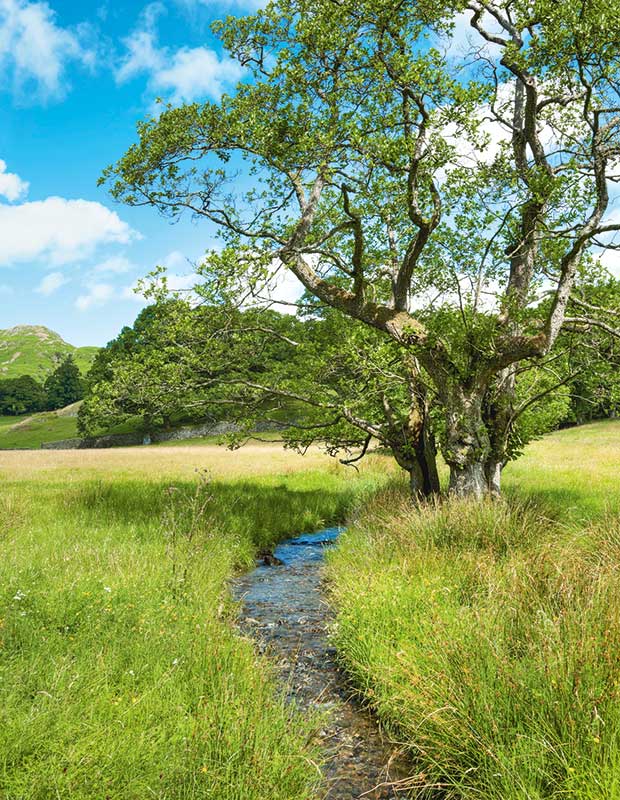
Most of the pilings of Venice are made from alder wood.
2. SHELTERBELTS
If shelterbelts conjure up a vision of regimented Japanese cedars pruned into 5m high green walls, please rethink this. What I am talking about are mixed hedgerows that are attractive, productive, provide habitat and food for birds and bugs (and you and your stock), and are effective windbreaks.
Shelterbelts should filter the wind. Filter is the operative word. A solid wall across the wind creates a vacuum on the leeward side and causes the wind to fall over it and dump down almost immediately.
Conversely, a porous wind filter that slows the wind can provide shelter for up to 20 times its height on the leeward side, and even provide protection on the upwind side.
I favour a layered shelter with a dense base of feijoa or flax that stock can tuck into, inter-planted with tall, porous upright trees to filter and slow the wind.
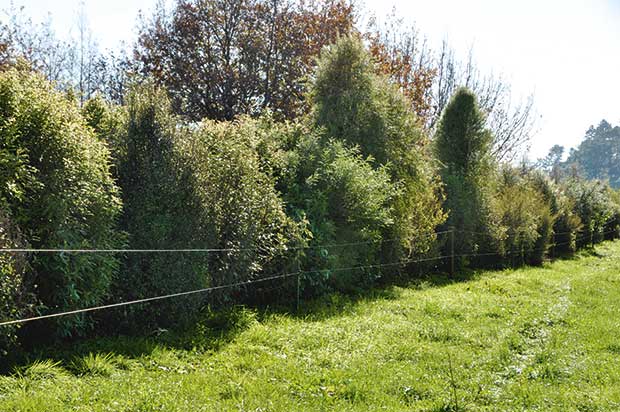
A mixed native hedgerow at Pokaiwhenua Tree Farm is successfully protected with just two hot wires.
Even the uprights can be multi-purpose. You can plant quick-growing trees for (almost) instant shelter, nitrogen-fixers for your soil, fruit, nut or fodder trees, or firewood options you can coppice.
If you only have a small property, consider a 3-5m high hedgerow on your windy side rather than large shelter trees.
The longer your shelterbelt, the better, as the wind will whip around the edges and funnel through the gaps.
Place your shelterbelt across the prevailing winds (west and south in my area) but not high across the northern side as you don’t want to block the sun.
Think carefully if planning to put your shelter along a boundary. Shelter is effective on both sides, and in future you may want access to both sides for maintenance. It’s useful to put in a driveway or a race to access the paddocks around the outside of your property, and have your shelter on the internal side of that race.
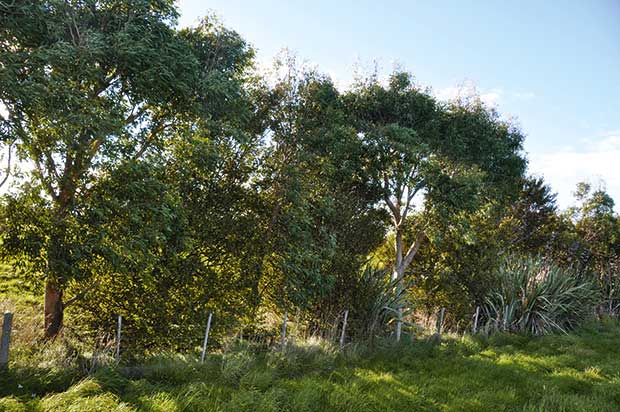
A mixed hedgerow can provide habitat ‘corridors’ for birds (and pests), firewood, fruit, fodder and nuts, plus shelter.
Take into account the contour of your land. Cold air sinks. A low, dense shelter on a slope can trap a ‘pond’ of cold air on the uphill side. In that case it is better that the lower growth is permeable to allow the cold to seep away.
Conversely, planting on top of a slope naturally increases the height and effectiveness of the shelter as the wind is already being directed upward by the contour of the land.
Fencing and protecting your shelterbelt from stock can be pretty cheap. Two parallel fences can protect a lot of trees. I prefer a solid netting fence with an electric outrigger to stop stock reaching over as I have pushy calves and I plant tasty trees. But I have seen mature cattle separated from natives with as little as two electric wires (see picture, top right).
3. MAN-MADE SHELTER
Like everything, you get out what you put in. Trees provide far more than just shelter for your stock. They extend your soil biological systems, provide food and habitat for a huge number of birds and insects, and can have an end use as timber or firewood.
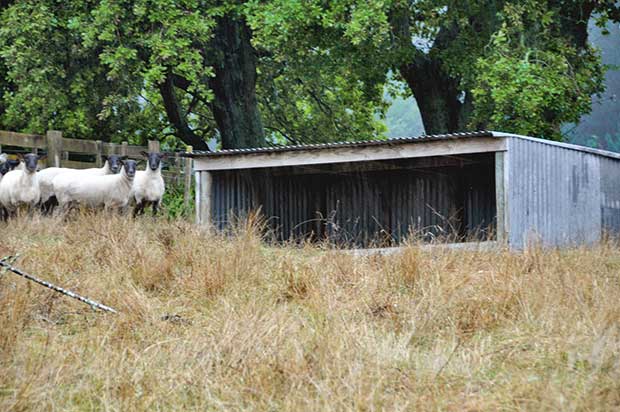
This three-sided low shed is easily closed off with a gate and divided up with old hay bales in winter to make a snug enclosure for lambing. At other times of year, sheep can access it as needed.
But they take maintenance. They need to be planted, protected, fed and released from weeds for the first couple of seasons. Branches may fall in storms and eventually trees may need to be felled or thinned. If this is not for you, consider investing in a shed your stock can access.
I have a dream. It is for a three-sided shed open to the morning sun in winter. The back half will be a hay shed, the front half shelter accessible from three different paddocks, the two separated by a small race I can use to run the stock through.
But a shed doesn’t have to be so elaborate. Hay bale walls and a couple of sheets of corrugated iron (secured so they don’t blow away) can provide shelter for sheep, goats or pigs. You can buy great kitset and movable shelters.
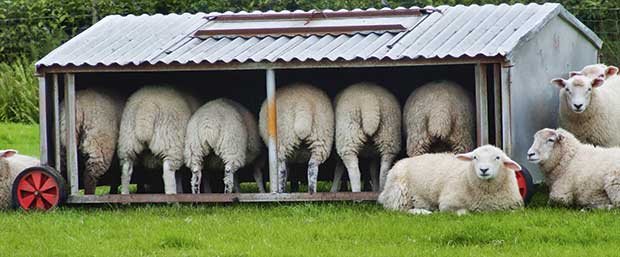
Bird droppings can carry bacteria and disease detrimental to your stock so ensure a shelter has rafters that are flush with the ceiling so you don’t create big perches.
For winter warmth, site your shelter on high ground with good drainage. Position the opening away from prevailing winds and preferably towards the sun. A base of sand, old woodchips, or straw with a gravel base adds a layer of insulation and drainage, but this may need annual maintenance.
AT SHERYN’S BLOCK
I have chosen to double-fence our internal fences with netting and electric outriggers and plant fruit trees.

Seedlings are planted and ruthlessly thinned. The exposure deters leaf curl and brown rot which flourish in sheltered, humid conditions. I get the fruit and the cows get the shade and shelter.
Love this story? Subscribe now!
 This article first appeared in NZ Lifestyle Block Magazine.
This article first appeared in NZ Lifestyle Block Magazine.
